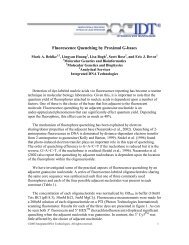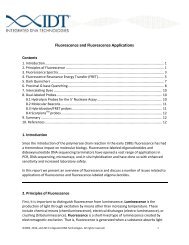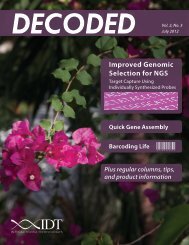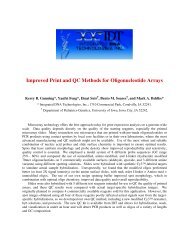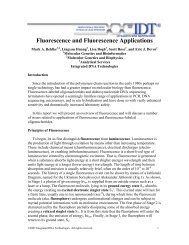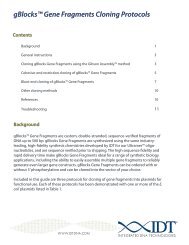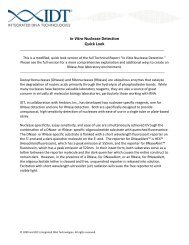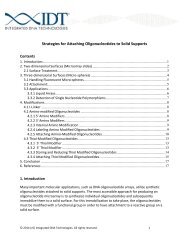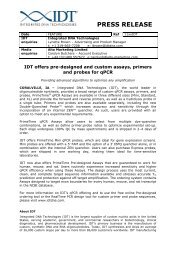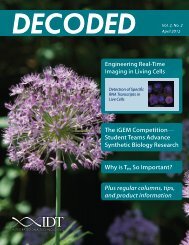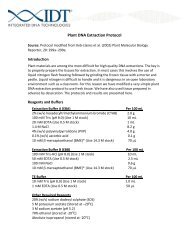Chemical Synthesis of Oligonucleotides - Integrated DNA ...
Chemical Synthesis of Oligonucleotides - Integrated DNA ...
Chemical Synthesis of Oligonucleotides - Integrated DNA ...
You also want an ePaper? Increase the reach of your titles
YUMPU automatically turns print PDFs into web optimized ePapers that Google loves.
<strong>Chemical</strong> <strong>Synthesis</strong> and Purification <strong>of</strong> <strong>Oligonucleotides</strong>Contents1. Introduction ................................................................................................................................ 12. A History <strong>of</strong> <strong>Chemical</strong> <strong>Synthesis</strong> .................................................................................................. 23. Contemporary Oligonucleotide <strong>Synthesis</strong> .................................................................................. 43.1 Deprotection ......................................................................................................................... 53.2 Coupling ................................................................................................................................ 53.3 Capping ................................................................................................................................. 63.4 Stabilization ........................................................................................................................... 63.5 Cleavage, Detritylation, Deprotection .................................................................................. 63.6 Desalting ............................................................................................................................... 64. <strong>Synthesis</strong> Scale and Yield ............................................................................................................ 75. Purification .................................................................................................................................. 85.1 PAGE ...................................................................................................................................... 85.2 HPLC ...................................................................................................................................... 85.3 Purification Quality Control .................................................................................................. 95.3.1 Mass spectrometry ........................................................................................................ 95.3.2 Capillary electrophoresis ............................................................................................. 106. Summary ................................................................................................................................... 117. References ................................................................................................................................ 111. IntroductionNearly every molecular biology technique in use today employs chemically synthesized <strong>DNA</strong>s orRNAs. This includes PCR, Real-Time PCR, <strong>DNA</strong> sequencing, site directed mutagenesis, singlenucleotidepolymorphism (SNP) assays, microarrays, and the rapidly expanding world <strong>of</strong> smallRNAs. Unlike other reagents, however, each oligonucleotide is custom made according to thespecific needs <strong>of</strong> the individual researcher and purified according to the application for which itis intended.In recent years, advances in oligonucleotide synthesis chemistries as well as in purification andquality control technologies have led to substantial increases in both quality and yield and tosubstantial decreases in cost. At the same time, developments in oligonucleotide applicationshave spurred a dramatic expansion <strong>of</strong> the range <strong>of</strong> available modifications. As technologicaladvances in applications have ushered in an era <strong>of</strong> high throughput analyses, so, too, haveadvances in oligonucleotide synthesis, purification, and QC led to the establishment <strong>of</strong> highthroughput manufacturing <strong>of</strong> the full range <strong>of</strong> possible syntheses such as those available at<strong>Integrated</strong> <strong>DNA</strong> Technologies.©2005, 2010, and 2011 <strong>Integrated</strong> <strong>DNA</strong> Technologies. All rights reserved. 1
Here, we give a brief history <strong>of</strong> chemical synthesis, present the fundamentals <strong>of</strong> chemicalsynthesis <strong>of</strong> oligonucleotides as it is practiced today, and present some <strong>of</strong> the more basic issuesarising from syntheses including those affecting scale and yield.2. A History <strong>of</strong> <strong>Chemical</strong> <strong>Synthesis</strong>The elucidation <strong>of</strong> the Genetic Code was accomplished by 1966 and is an example <strong>of</strong> bruteforce applied to a delicate problem. One <strong>of</strong> the main figures was Pr<strong>of</strong>essor H. Gobind Khorana,a biochemist at the University <strong>of</strong> Wisconsin. It was understood then that, in nature, theformation <strong>of</strong> the phosphate linkages in <strong>DNA</strong> was catalyzed enzymatically in a reversiblereaction:dNTP + (dNMP) n ↔ (dNMP) n+1 + pp iThat is, a deoxynucleotide triphosphate was added to a growing deoxynucleotidemonophosphate polymer by a polymerase in the presence <strong>of</strong> Mg ++ and the forward reactionresulted in the n+1 polymer and a pyrophosphate. Based on this understanding, Khorana, andother investigators, began to try ways to accomplish the reaction synthetically. Many <strong>of</strong> theseinvestigators were already well versed in the chemistry involved in the synthesis <strong>of</strong>polypeptides. This very successful chemistry, shown graphically in Figure 1, utilized afoundation <strong>of</strong> a single amino acid bound to a solid support (in this case a resin bead), aprotected amino acid, and a condensing agent, dicyclohexylcarbodiimide (DCC) which catalyzedCH 3 H RCH 3 -C-O-C-N-C-COOHCH 3 O HRH 2 N-C-C-H ODCCResin BeadCondensing AgentBlocking GroupCH 3HRHCH 3 -C-O-C-N-C-C- N-C- + H 2 OC-CH 3 O H O R OGrowing PolypeptideFigure 1. The basic scheme <strong>of</strong> polypeptide synthesis from a solid support(resin bead). The final deprotection step removed the blocking group from thecoupled amino acid and permitted the next coupling reaction to proceed in thepresence <strong>of</strong> DCC.©2005, 2010, and 2011 <strong>Integrated</strong> <strong>DNA</strong> Technologies. All rights reserved. 2
the peptide linkage. The reaction would link the protected amino acid to the solid support inonly one way and the resulting di-peptide was then deprotected for the addition <strong>of</strong> the nextamino acid. In this way, the synthetic polypeptide grew at the direction <strong>of</strong> the synthesizingchemist one link at a time through a repeated cycle <strong>of</strong> steps.Khorana and his group at the Institute for Enzyme Research at the University <strong>of</strong> Wisconsinbegan experimenting with DCC on various solid supports and protecting groups on bothribonucleotides and deoxyribonucleotides. The scheme they developed involved threedifferent protecting groups surrounding the nucleotide (Figure 2). The integrity <strong>of</strong> the ringstructure <strong>of</strong> the base was protected by a benzoyl or an isobutyryl group, the oxygen on the 3’carbon <strong>of</strong> the sugar was prevented from forming a reactive hydroxyl until needed by theaddition <strong>of</strong> an acetyl group, and the 5’ carbon was blocked by a trityl group. In the synthesis <strong>of</strong>the trityl group Khorana chose to use a soluble polymeric support. In the case <strong>of</strong> polypeptidesynthesis the support was a resin bead but Khorana settled on a polystyrene bead for nucleicacid synthesis. <strong>Synthesis</strong> <strong>of</strong> the trityl began with the attachment <strong>of</strong> a benzene ring to thepolystyrene bead. Next, asecond ring was attached viaa Friedel-Crafts reactionwhich is the acetylation (oralkylation) <strong>of</strong> aromaticcompounds by aluminumchloride. This structure wasthen exposed to a Grignardreagent, an extremelyreactive class <strong>of</strong> compoundsused in the synthesis <strong>of</strong>hydrocarbons. Finally, thenearly completed trityl groupwas treated with acetylchloride resulting in apolystyrenemethoxytritylchloride speciesthat could be easily attachedto the 5’ carbon <strong>of</strong> thepentose sugar (Figure 2).PolystyreneSolid SupportTritylGroupCoAcetyl GroupoAoB PBenzoyl orIsobutyryl GroupFigure 2. Starting point structure <strong>of</strong> an oligonucleotide synthesisby the Khorana group. Subsequent couplings would proceedthrough the 3’ carbon after removal <strong>of</strong> the acetyl group. Allnucleotides added from this point would have a reactive hydroxylin place <strong>of</strong> the trityl group but would retain the other twoprotecting groups.By placing the solid support on the trityl group and using the DCC condensing reagent,the synthesis <strong>of</strong> an oligodeoxynucleotide proceeded in the same 5’→3’ direction as in nature.The nucleotide to which the trityl was attached became the anchor <strong>of</strong> the synthesis. The oxygenon the 3’ carbon <strong>of</strong> the sugar was deprotected leaving the reactive hydroxyl group ready forcoupling. The protected nucleotide, without a trityl, was added via the condensing reaction <strong>of</strong>DCC. This method was tedious and only modestly efficient but it led to two majorbreakthroughs. First, Khorana and his group were able to synthesize oligoribonucleotides thatwere used to confirm the Genetic Code. Second, in 1967, the Khorana-led team at Wisconsinannounced their intention to use this chemistry to synthesize a gene. Their attempt to do this©2005, 2010, and 2011 <strong>Integrated</strong> <strong>DNA</strong> Technologies. All rights reserved. 3
was catalyzed by the discovery in that year <strong>of</strong> the enzyme, <strong>DNA</strong> ligase. Khorana realized thatthey could synthesize overlapping, complementary oligodeoxynucleotides and assemble thegene using the ligase. In 1968, Khorana received the Nobel Prize in Physiology or Medicine fortheir interpretation <strong>of</strong> the genetic code and its function in protein synthesis. In 1970 theypublished the first completely synthetic gene, the 77bp yeast tRNA Ala gene [1]. In this Naturearticle, they noted, “Unpublished experiments by two <strong>of</strong> us have given encouraging results onthe use <strong>of</strong> <strong>DNA</strong> polymerase for replication <strong>of</strong> the gene in the presence <strong>of</strong> suitable primers.” [1].Some have speculated that this statement may have been the beginning <strong>of</strong> the invention <strong>of</strong>PCR.3. Contemporary Oligonucleotide <strong>Synthesis</strong>In spite <strong>of</strong> the successes <strong>of</strong> researchers like Khorana, chemical synthesis <strong>of</strong> oligonucleotidesremained labor intensive and inefficient throughout the 1970’s and into the early 1980’s. In1983, a breakthrough was achieved in synthesis chemistry that made it possible to make longeroligonucleotides and to make them much more efficiently. The new synthesis process wasbased on the use <strong>of</strong> phosphoramidite monomers as building blocks and the use <strong>of</strong> tetrazolecatalysis [2]. A phosphoramidite monomer is a very different synthesis unit compared to itspredecessors. First, a phorphoramidite is a normal nucleotide but with protection groups, suchas a trityl group, added to its reactive amine, hydroxyl, and phosphate groups. Theseprotection groups prevent unwanted side reactions and force the formation <strong>of</strong> the desiredproduct during synthesis (Figure 3). Theprotection groups are removed after thecompletion <strong>of</strong> the synthesis process.Second, the link to the solid support is madethrough the 3’ carbon and synthesisproceeds 3’ to 5’ rather than the 5’ to 3’synthesis used previously (Figure 4A). Thesolid support is a 5 micron controlled poreglass bead (CPG) with holes and channelswhere the protected nucleotide is attached(Figure 4B). The advances in oligonucleotidesynthesis chemistries have resulted insubstantial increases in quality and yield withthe added advantage <strong>of</strong> decreasing cost.This is particularly important since each Figure 3. Protection Groupsoligonucleotide has to be custom madedependent on the needs <strong>of</strong> the individual researcher.Phophoramidite synthesis begins with the 3’-most nucleotide and proceeds through a series <strong>of</strong>cycles composed <strong>of</strong> fours steps that are repeated until the 5’-most nucleotide is attached.These steps are deprotection, coupling, capping, and stabilization.©2005, 2010, and 2011 <strong>Integrated</strong> <strong>DNA</strong> Technologies. All rights reserved. 4
A. B.Figure 4. A. A protected nucleoside attached to a CPG. B. An electronphotomicrograph <strong>of</strong> the surface <strong>of</strong> a CPG bead. The scale <strong>of</strong> this picture is 10millionths <strong>of</strong> an inch square.3.1 DeprotectionIn the classic deprotection step, the trityl group, which is attached to the 5’ carbon <strong>of</strong> thepentose sugar <strong>of</strong> the recipient nucleotide, is removed by trichloroacetic acid (TCA) leaving areactive hydroxyl group to which the next base is added.3.2 CouplingIt is here that the advent <strong>of</strong> tetrazole activation replaces the use <strong>of</strong> condensing agents like DCC.Berner et al. showed that tetrazole, a weak acid, attacks the coupling phosphoramiditenucleoside forming a tetrazolyl phosphoramidite intermediate [3]. This structure then reactswith the hydroxyl group <strong>of</strong> the nucleoside attached to the CPG bead and the 5’ to 3’ linkage isformed (Figure 5). The unbound base and by-products are washed out, the tetrazole isreconstituted, and the process continues. The use <strong>of</strong> tetrazole increased coupling efficiency togreater than 99% which allowed longer and longer oligonucleotides to be synthesized.Figure 5. The pathway <strong>of</strong> tetrazole phosphoramidite-intermediate coupling. Thephosphoramidite is introduced in the presence <strong>of</strong> tetrazole which protonatesdiisopropylamine leading to the formation <strong>of</strong> the tetrazole phosphoramiditeintermediate. Coupling <strong>of</strong> the intermediate to the growing oligonucleotide is thefinal step which returns the tetrazole to its original state.©2005, 2010, and 2011 <strong>Integrated</strong> <strong>DNA</strong> Technologies. All rights reserved. 5
3.3 CappingWhile the increased efficiency afforded by the advent <strong>of</strong> tetrazole phosphoramiditeintermediatecoupling was a major advance in oligonucleotide synthesis, it was still a chemicalprocess and so had a finite failure rate. A coupling failure results when an oligonucleotideretains a reactive hydroxyl group on its 5’-most end. If this were to remain freely reactive, itwould be able to couple in the next round and would result in a missing base in the synthesis.Thus, coupling failures must be removed from further participation in the synthesis. This isaccomplished by adding an acetylating reagent composed <strong>of</strong> acetic anhydride and N-methylimidazole. This reagent reacts only with free hydroxyl groups to irreversibly cap theoligonucleotides in which coupling failed.3.4 StabilizationOnce the capping step is accomplished, the last step in the cycle is oxidation which stabilizesthe phosphate linkage between the growing oligonucleotide chain and the most recently addedbase. The phosphate linkage between the first and second base must be stabilized by makingthe phosphate group pentavalent. This is achieved by adding iodine and water which leads tothe oxidation <strong>of</strong> the phosphite into phosphate leaving the phospho-triester bond stabilized.3.5 Cleavage, Detritylation, DeprotectionThis cycle is repeated for each nucleotide in the sequence. At the end <strong>of</strong> the synthesis theoligonucleotide exists as, for example, a 25-mer with the 3’ end still attached to the CPG andthe 5’ end protected with a trityl group. In addition, protecting groups remain on three <strong>of</strong> thefour bases to maintain the integrity <strong>of</strong> the ring structures <strong>of</strong> the bases. The protecting groupsare benzoyl on A and C and N-2-isobutyryl on G (figure 6). Thymidine needs no protectinggroup. The completed synthesis is detritylated and then cleaved <strong>of</strong>f the CPG leaving a hydroxylon both the 3’ and 5’ ends. At this point the oligo (base and phosphate) is deprotected by basehydrolysis using ammonium hydroxide at high temperature. The final product is a functionalsingle-stranded <strong>DNA</strong> molecule.Figure 6. Structures <strong>of</strong> the four nucleoside phosphoramidite monomers. The benzoyl andisobutyryl protecting groups on the A, C, and G monomers are shown.3.6 DesaltingAlthough deprotection removes the protecting groups, they remain with the oligonucleotide asorganic salts. The process <strong>of</strong> removing these contaminants is called desalting.©2005, 2010, and 2011 <strong>Integrated</strong> <strong>DNA</strong> Technologies. All rights reserved. 6
4. <strong>Synthesis</strong> Scale and YieldScale refers to the amount <strong>of</strong> starting material which is composed solely <strong>of</strong> the 3’-mostnucleotide <strong>of</strong> a sequence attached to a solid support used to make the oligonucleotide.Yield refers to the amount <strong>of</strong> final product recovered after all the synthesis, processing, andpurification steps associated with the oligonucleotide have been completed.As noted above, because <strong>of</strong> chemical and physical restraints, coupling efficiency is less than100% at each step in the synthesis. In addition, coupling efficiency varies for each base both bytype and position in the growing oligonucleotide [4, 5]. IDT’s experience gained from thesynthesis <strong>of</strong> millions <strong>of</strong> oligonucleotides shows that some sequences will result in better yieldsthan others. Monitoring efforts at IDT confirm that our average coupling efficiency foroligonucleotides exceeds 99%. This means that the failure rates should be 1% or less percoupling event. However, this results in a cumulative population <strong>of</strong> failures. For a 25-mer witha 99.5% coupling efficiency, the percentage <strong>of</strong> full-length product can be estimated as (.995) 24which is equal to 88.6% full-length product (FLP). For a 25-mer with a 99% coupling efficiency,the estimated FLP would be 78.5%. (Figure 7). The exponent is (n-1) because the very first baseon the 3’ end is given as a result <strong>of</strong> the CPG. Thus, while there are 25 nucleotides there are only24 couplings.Based on the relationship between expected yield and the actual scale <strong>of</strong> the synthesis, IDTroutinely <strong>of</strong>fers yield guarantees based upon a combination <strong>of</strong> oligonucleotide length andsynthesis scale. <strong>Synthesis</strong> <strong>of</strong> very long oligonucleotides (those greater than 60 bases) isproblematic. Thus, IDT does not <strong>of</strong>fer any yield guarantees for oligonucleotides greater than 60bases at our highest synthesis scale and greater than 100 bases on any scale.Yield1.0000.9000.8000.7000.6000.5000.4000.3000.2000.1000.000Efficiency0.9950.9900.980010 20 30 40 50 60 70 80 90100Oligonucleotide LengthFigure 7. Relationship between average coupling efficiency and synthesisyield over a range <strong>of</strong> oligonucleotide lengths.©2005, 2010, and 2011 <strong>Integrated</strong> <strong>DNA</strong> Technologies. All rights reserved. 7
Most PCR primers are in the 20- to 28-mer range which means that a standard synthesis willcontain between 85% and 90% full-length product. For PCR applications, the overwhelmingmass <strong>of</strong> full-length product will be sufficient to produce the amplicon <strong>of</strong> interest in an equallyoverwhelming mass. Thus, for PCR, there is little need for purification beyond that <strong>of</strong> desaltingparticularly with the very high quality <strong>of</strong> oligos that IDT maintains. IDT also <strong>of</strong>fers standarddesalting for products with a number <strong>of</strong> the more common modifications appropriate for manyapplications (see the IDT website for more information).As a general rule, IDT recommends that any oligonucleotide longer than 40 bases shouldreceive further purification. In addition, for demanding applications such as site-directedmutagenesis, cloning, and gel-shift protein-binding assays, additional purification isrecommended even for oligonucleotides shorter than 40 bases. Please note that additionalpurification will result in a decrease in final oligonucleotide yield.5. PurificationPurification <strong>of</strong> an oligonucleotide is application-dependent. For longer oligonucleotides, such asthose that are typically used for cloning and hybridization applications, purification is importantbecause the non-full-length mass might interfere with the applications. Similarly,oligonucleotides modified with non-standard bases, fluorescent dyes, linkers, etc. should besubjected to additional purifications.IDT uses two methods for post-production purification:1. Polyacrylamide gel electrophoresis (PAGE)2. High performance liquid chromatography (HPLC)5.1 PAGEHigh percentage acrylamide gels are used to separate and elute the full-length product from allshorter species with great efficiency. PAGE is the most efficient means <strong>of</strong> purification foroligonucleotides that are unmodified and only need to have the capped products removed.PAGE purification does result in an unavoidable loss <strong>of</strong> mass because it is physically impossibleto recover every bit <strong>of</strong> full-length product from a gel slice. Thus, a PAGE-purified 50-mer willyield a substantially lower mass relative to the starting synthesis scale. However, the loss <strong>of</strong>mass is typically an acceptable trade for the increase in purity. PAGE purification is stronglyrecommended for oligos over 60 bases in length. For unmodified oligos, purity <strong>of</strong> >90% isroutinely achieved.5.2 HPLCHPLC utilizes the concept that a 25-mer oligonucleotide will have a specific charge and a specificaffinity, or lack <strong>of</strong> affinity for particular solvents. This method is usually reserved foroligonucleotides that have been modified through the addition <strong>of</strong> a linker or spacer, a non-©2005, 2010, and 2011 <strong>Integrated</strong> <strong>DNA</strong> Technologies. All rights reserved. 8
standard base or bases, or hydrophobic molecules. HPLC is a form <strong>of</strong> column chromatographythat utilizes a column to hold a stationary phase while the sample is applied within a mobilephase. The analyte's motion through the column is slowed by specific chemical or physicalinteractions with the stationary phase as it passes through the length <strong>of</strong> the column. Theamount <strong>of</strong> retardation depends on the nature <strong>of</strong> the analyte, stationary phase and mobilephase composition and, thus, retention time is unique for each analyte.HPLC comes in two basic forms.1) Reverse-phase HPLC - separation is on the basis <strong>of</strong> the difference in solvent affinitybetween modified and unmodified oligonucleotide.2) Ion-exchange HPLC - separation is on the basis <strong>of</strong> the differences in the net chargebetween modified and unmodified oligonucleotide.The type <strong>of</strong> HPLC used is dependant on the particular sample. Again, there will be anunavoidable loss <strong>of</strong> mass due to purification but this will be <strong>of</strong>fset by the gain in purity.5.3 Purification Quality ControlSynthesizing and purifying an oligonucleotide does not provide information about the quality <strong>of</strong>the oligonucleotide. The oligonucleotide can be tested for quality prior to its use in anexperiment through two methods:1) Mass spectrometry2) Capillary electrophoresis (CE)5.3.1 Mass spectrometryTwo types <strong>of</strong> Mass spectrometry may be employed:1) MALDI-TOF: Matrix Assisted Laser Desorption Ionization – Time Of Flight2) ESI: Electrospray IonizationMALDI-TOF can resolve oligonucleotides up to 50 bases in length (~15,000 Daltons) andis based on the principle that the speed at which an ion moves is inversely proportional to itsmass. Thus, in the ion chamber <strong>of</strong> a MALDI instrument, materials are ionized and given thesame potential energy, eV, where V is the potential and e refers to the number <strong>of</strong> charges onthe ion. As the ions emerge from the ion source, the potential is converted to kinetic energy inthe moving ion. Ions in motion obey the rule E = 1/2mv 2 , or m = 2E/v 2 , where m is the mass <strong>of</strong>the ion, v is velocity, and E is energy. Since the amount <strong>of</strong> energy is a constant in the MALDI,the mass <strong>of</strong> the ion can be determined by velocity alone. Velocity is simply time over distancesuch that the time <strong>of</strong> arrival <strong>of</strong> the ion in the detector <strong>of</strong> the MALDI (time <strong>of</strong> flight) is directlyconverted to velocity because the distance is a constant as well. In oligonucleotide synthesisQC, MALDI-TOF has the added advantage that the mass <strong>of</strong> an oligonucleotide can be estimatedwith precision since the masses <strong>of</strong> the individual nucleotides are fixed (Figure 8). For any givensequence, the expected arrival time will be given by the expected mass and any deviation fromthat time <strong>of</strong> arrival will indicate a deviation from ideal size and/or purity.©2005, 2010, and 2011 <strong>Integrated</strong> <strong>DNA</strong> Technologies. All rights reserved. 9
Electrospray Ionization (ESI) mass spectrometry can resolve longer oligonucleotides (upto ~150 bases in length). The material to be analyzed by ESI begins in liquid form and isdispersed into a fine aerosol by electrospray. The aerosol enters a heated capillary where anyremaining solvent is evaporated from the charged droplets. Smaller droplets will evaporatemore quickly than larger droplets. Once the solvent is evaporated, only the ions remain in thegas phase. The ions will have a variety <strong>of</strong> charges and so will hit the detector at different timesbased on the charge. Based on the peak from when an ion hits the detector, the charge state isdetermined and then, from this, the mass.Figure 8. Example <strong>of</strong> a Mass spectrometry trace. The main peak is the mainproduct at the indicated mass in Daltons.5.3.2 Capillary electrophoresisCapillary electrophoresis uses a small amount <strong>of</strong> the final synthesis product that issubjected to a constant electrical field in a hair-thin capillary. As the product migrates into thecapillary it is separated into component sizes in a manner exactly like gel electrophoresis. Thefragments will migrate past an optical window and an ultraviolet beam detector will assess thedensity <strong>of</strong> the fragments. The “trace” that is produced is composed <strong>of</strong> a series <strong>of</strong> peakscorresponding to material densities flowing past the detector (Figure 9). This density pr<strong>of</strong>ile ismade quantitative by establishing a base line and integrating the area under the individualpeaks. The purity <strong>of</strong> the product is the ratio <strong>of</strong> the main peak to the total area under all peaks.In practice, the main peak should be the last peak since no species should be longer than thefull-length product. Peaks that appear to the right <strong>of</strong> the main peak indicate residual impuritiesand other potential contaminants.©2005, 2010, and 2011 <strong>Integrated</strong> <strong>DNA</strong> Technologies. All rights reserved. 10
Figure 9. A capillary electrophoresis <strong>of</strong> an oligonucleotide synthesis.The axes are uV absorbance units (AU) versus time on the column inminutes. The main peak is clearly the dominant peak and the “shoulder”to the left is the (n-1)-mer peak. Note, there is no material detected tothe right. The ratio <strong>of</strong> the main peak to the total indicates a puritygreater than 95%.6. SummaryThe history <strong>of</strong> chemical synthesis <strong>of</strong> oligonucleotides goes back to the discovery <strong>of</strong> <strong>DNA</strong> itself.The model <strong>of</strong> contemporary oligonucleotide synthesis including protected synthesis units, solidsupport anchors, and end-to-end synthesis, dates to the first attempts to synthesizepolypeptides in the 1930’s. The advent <strong>of</strong> phosphoramidite chemistry involving tetrazoleintermediates in the 1980’s made it possible to make longer and longer oligonucleotides and tomake standard lengths faster and far more efficiently. Coupled with this, the transition <strong>of</strong>techniques like PAGE, HPLC, Mass spectrometry, and CE and MALDI to high throughputanalytical platforms, has made the synthesis <strong>of</strong> high quality, high purity oligonucleotides on anindustrial scale possible at <strong>Integrated</strong> <strong>DNA</strong> Technologies.7. References1. Agarwal KL, Buchi H, et al. (1970) Total synthesis <strong>of</strong> the gene for an alanine transferribonucleic acid from yeast. Nature, 227(5253): 27 34.2. McBride LJ and Caruthers MH. (1983) An investigation <strong>of</strong> several deoxynucleosidephosphoramidites useful for synthesizing deoxyoligonucleotides. Tetrahedron Letters,24(3): 245 248.3. Berner S, Muhlegger K, and Seliger H. (1989) Studies on the role <strong>of</strong> tetrazole in theactivation <strong>of</strong> phosphoramidites. Nucleic Acids Res, 17(3): 853 864.©2005, 2010, and 2011 <strong>Integrated</strong> <strong>DNA</strong> Technologies. All rights reserved. 11
4. Temsamani J, Kubert M, and Agrawal S. (1995) Sequence identity <strong>of</strong> the n-1 product <strong>of</strong> asynthetic oligonucleotide. Nucleic Acids Res, 23(11): 1841 1844.5. Hecker KH and Rill RL. (1998) Error analysis <strong>of</strong> chemically synthesized polynucleotides.Biotechniques, 24(2): 256 60.©2005, 2010, and 2011 <strong>Integrated</strong> <strong>DNA</strong> Technologies. All rights reserved. 12



